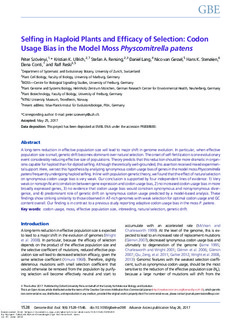| dc.contributor.author | Szövényi, Péter | |
| dc.contributor.author | Ullrich, K | |
| dc.contributor.author | Rensing, SA | |
| dc.contributor.author | Lang, D | |
| dc.contributor.author | van Gessel, Nico | |
| dc.contributor.author | Stenøien, Hans K. | |
| dc.contributor.author | Conti, Elena | |
| dc.contributor.author | Reski, Ralf | |
| dc.date.accessioned | 2018-06-18T11:00:49Z | |
| dc.date.available | 2018-06-18T11:00:49Z | |
| dc.date.created | 2017-09-04T14:43:44Z | |
| dc.date.issued | 2017 | |
| dc.identifier.citation | Genome Biology and Evolution. 2017, 9, 1528-1546. | nb_NO |
| dc.identifier.issn | 1759-6653 | |
| dc.identifier.uri | http://hdl.handle.net/11250/2501876 | |
| dc.description.abstract | A long-term reduction in effective population size will lead to major shift in genome evolution. In particular, when effective population size is small, genetic drift becomes dominant over natural selection. The onset of self-fertilization is one evolutionary event considerably reducing effective size of populations. Theory predicts that this reduction should be more dramatic in organisms capable for haploid than for diploid selfing. Although theoretically well-grounded, this assertion received mixed experimental support. Here, we test this hypothesis by analyzing synonymous codon usage bias of genes in the model moss Physcomitrella patensfrequently undergoing haploid selfing. In line with population genetic theory, we found that the effect of natural selection on synonymous codon usage bias is very weak. Our conclusion is supported by four independent lines of evidence: 1) Very weak or nonsignificant correlation between gene expression and codon usage bias, 2) no increased codon usage bias in more broadly expressed genes, 3) no evidence that codon usage bias would constrain synonymous and nonsynonymous divergence, and 4) predominant role of genetic drift on synonymous codon usage predicted by a model-based analysis. These findings show striking similarity to those observed in AT-rich genomes with weak selection for optimal codon usage and GC content overall. Our finding is in contrast to a previous study reporting adaptive codon usage bias in the moss P. patens. | nb_NO |
| dc.language.iso | eng | nb_NO |
| dc.publisher | Oxford University Press/ Society for Molecular Biology and Evolution | nb_NO |
| dc.rights | Navngivelse-Ikkekommersiell 4.0 Internasjonal | * |
| dc.rights.uri | http://creativecommons.org/licenses/by-nc/4.0/deed.no | * |
| dc.title | Selfing in haploid plants and efficacy of selection: codon usage bias in the model moss Physcomitrella patens | nb_NO |
| dc.type | Journal article | nb_NO |
| dc.type | Peer reviewed | nb_NO |
| dc.description.version | publishedVersion | nb_NO |
| dc.source.pagenumber | 1528-1546 | nb_NO |
| dc.source.volume | 9 | nb_NO |
| dc.source.journal | Genome Biology and Evolution | nb_NO |
| dc.identifier.doi | 10.1093/gbe/evx098 | |
| dc.identifier.cristin | 1490808 | |
| dc.description.localcode | © The Author 2017. Published by Oxford University Press on behalf of the Society for Molecular Biology and Evolution. This is an Open Access article distributed under the terms of the Creative Commons Attribution Non-Commercial License (http://creativecommons.org/licenses/by-nc/4.0/), which permits non-commercial re-use, distribution, and reproduction in any medium, provided the original work is properly cited. For commercial re-use, please contact journals.permissions@oup.com | nb_NO |
| cristin.unitcode | 194,31,10,0 | |
| cristin.unitname | Institutt for naturhistorie | |
| cristin.ispublished | true | |
| cristin.fulltext | original | |
| cristin.qualitycode | 1 | |

